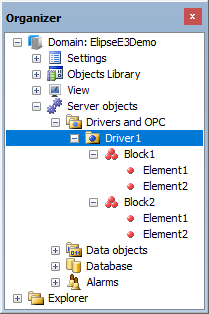Importing and exporting objects in Elipse E3 can be performed for any type of object, except for projects and libraries. An operation starting at a root object is performed on its properties and child objects. To export objects, follow these procedures:
1.Right-click an object and select Export.
2.On the dialog box, select a CSV file and click Save.

Exporting an object
During the export procedure, all properties, Links, collections, and collection items from the selected object and from its children are automatically exported. A CSV file is then generated with one row for each exported object, as well as for each Link, collection, or collection item available on these objects. For each property, a column is created on a file, where it is informed the value of that property for each object.
The selected object, called a root object, is exported with the Name property's column blank. For all other cases, this column contains a hierarchy with names separated by dots. An example of an export process starting at an IODriver object is shown on the next figure.

Hierarchy of a Driver object
ObjectType;Name;Prop1;Prop2;Prop3
IODriver;;0;True;0
IOBlock;Block1;0;False;0
IOBlockElement;Block1.Element1;0;False;0
IOBlockElement;Block1.Element2;0;False;0
IOBlock;Block2;0;False;0
IOBlockElement;Block2.Element1;0;False;0
IOTag;Tag1,0,True,0
If needed, users can configure object exporting using templates, which are presented on topic Templates. When using a template, users can configure whether Links, collections, and collection items are exported or not, whether a root object is exported or not, and which properties of each object must be exported, among other configurations. To do so, follow these procedures:
1.Right-click an object and select Export.
2.Click Advanced to configure or select a template.
3.On the dialog box, select a CSV file and then click Save.
To import objects, follow these procedures:
1.Right-click an object and select Import.
2.On the dialog box, select a CSV file and then click Open.

Importing objects
When importing, for each row read from a CSV file, there is an identification of an object to create. Only the child at the end of the hierarchy can be created. The remaining path must already exist. For example, in an object Folder1.Folder2.Tag, only Tag can be created. Folder1 and Folder2 must exist previously. So, it is allowed to have only folders on a file, without children. This file may have rows such as the next example.
ObjectType;Name
IOFolder;Folder1
Blank rows, rows where no valid identifier is found, blank columns, and columns with invalid property names are ignored, without generating an error.